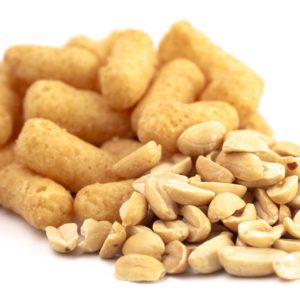
You can help prevent peanut allergy by introducing peanuts to your infant at the right time by following these life-changing guidelines.
In 2010, 2% of children had a peanut allergy, which was up from 0.4% in 1999. (1) Before you dive into giving your child peanuts, it’s important to introduce other foods to make sure he can tolerate food. Then you can start to phase in peanuts, making sure to follow these specific guidelines to prevent peanut allergy.
What does the research say about preventing peanut allergy and early introduction?
A five-year study examined 640 high-risk, 4-11-month-old children who had eczema and/or a severe egg allergy. (1) Half of the children were given peanut foods. The results showed that there was up to an 86% reduction in peanut allergy with the children who were given the peanuts. Additional research saw that this lasted even if peanuts were taken out of the diet afterward. (2) Read more about this in When & How to Introduce Peanut Butter to Your Baby. This was a big step to show that introducing peanuts early is safe and can help prevent peanut allergy when done in the proper amounts and at the right time.
Risk and Proper Time to Introduce Peanuts
Some infants may be at higher risk for peanut allergy than others. Risk depends on many factors, one of which is the prevalence of food allergies in the immediate family. Risk increases as the number of family members who have that allergen increases – one parent, versus two parents, versus parents and siblings. There are three main categories – high, moderate, and low risk. (3)
Before introducing nuts to your infant or child, make sure she is healthy without any signs of illness, such as fever, vomiting, or fatigue. Do this in the morning, and watch for any signs or symptoms of a reaction for two hours.
High-risk
A high-risk child has an egg allergy, moderate to severe eczema, or both. It is important not to introduce peanuts until speaking with a health care professional. They may recommend the first oral introduction at the doctor’s office. The time for allergen introduction is also sooner for this population, starting from 4-6 months of age. After that, the key is to make sure your child has 2 grams of peanut protein three times per week. Examples of this amount are given later on in this article.
Moderate-risk
If your child has mild eczema, it is an indicator that he or she may be at moderate risk. So, at 6 months, or shortly after, you can introduce peanuts at home.
Low-risk
A low-risk child has no symptoms of allergy or eczema. Similar to moderate-risk, you can introduce peanuts at home at 6 months or after. Just make sure not to wait too long!
Does eating peanuts while breastfeeding prevent peanut allergy?
Exposure via breastfeeding and early introduction can reduce sensitization (symptoms from eating the food will likely be inconsistent), but there is still not a solid answer in terms of reducing food allergy. If you don’t love peanuts, don’t force yourself to eat them. However, if you don’t mind them, or if you absolutely love them, feel free to include them. Tree nuts and seeds (i.e., sesame) and all nuts are safe during pregnancy. There are even other known benefits of eating nuts and seeds during pregnancy and for general health. More research is still needed about the maternal diet and how it influences allergies.
How to Reach 2g of Peanut Protein
Here are foods to introduce as recommended by the recently revised guidelines to reach the 2g amount: (1)
- 21 pieces of Bamba, or similar puffed peanut product (softened with water for children under 7 months)
- 2 teaspoons of peanut butter with 2-3 teaspoons of water thinned down (hot then cooled down after mixed)
- 2 teaspoons of peanut butter blended with 2-3 tablespoons of fruit and/or vegetables
- 2 teaspoons of peanut flour/peanut butter powder blended with 2 tablespoons of fruit and/or vegetables
Keep in mind that each child may tolerate different tastes and consistencies, so adjust as necessary when mixing water, fruits, or vegetables.
For an even more in-depth look at the research around preventing peanut allergy, check out The Best Time to Introduce Peanuts to Your Child.












